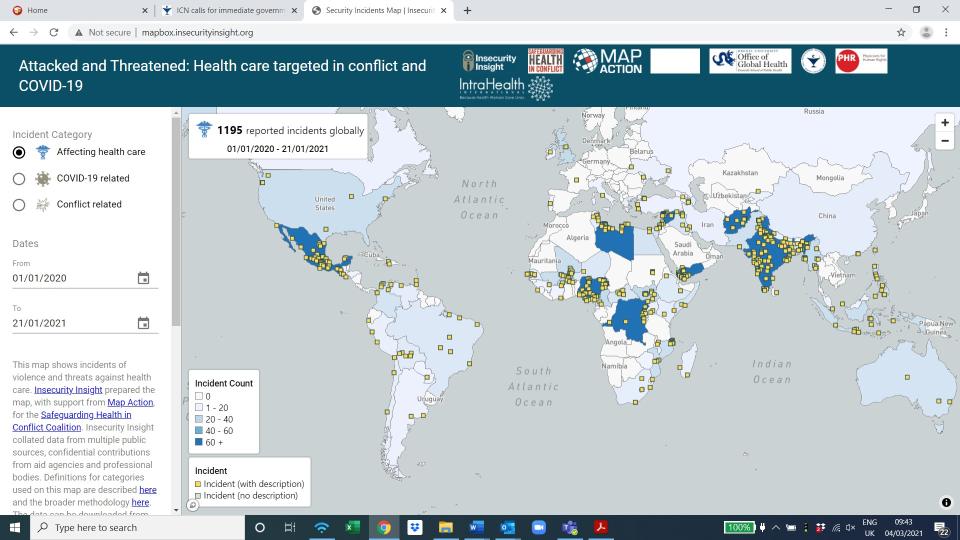ICN condemns over 400 incidents of pandemic-related violence and threats against health workers

A new interactive map, the Violence against Health Care Related to COVID-19 and Conflict Map, and an accompanying research brief highlights 1,172 attacks and threats against health workers, facilities and transport around the world during 2020, as the COVID-19 pandemic pushed health systems to their limits and sparked widespread violence against frontline health workers.
The map - developed by Insecurity Insight with support from MapAction and the Safeguarding Health in Conflict Coalition (SHCC) - displays information about attacks on healthcare drawn from credible media reports as well as reporting by intergovernmental organisations, states, and NGO partners. In addition to data from public sources, confidential contributions from aid agencies and professional bodies are included in the figures.
Some 412 of these 1,172 incidents were directly related to the COVID-19 pandemic and response measures, such as the arson of COVID-19 testing facilities, the targeting of health workers on their way home from clinics, and violent responses to mask requirements. The COVID-19-related attacks reveal a disturbing new dimension of violence against health care, which has in the past related primarily to attacks on health care amid armed conflict or routine health services provision.
ICN, a founding member of the Safeguarding Health in Conflict Coalition (SHCC), contributed significantly to this work. Howard Catton, ICN’s Chief Executive Officer said:
“Health workers are being put at increased risk at a time when their communities need them more than ever. The fact that they fear violence and abuse while on the front lines carrying out essential work is completely unacceptable and is adding to the mass traumatisation that they are experiencing. Governments and all stakeholders must do their part and take immediate action to stop this violence. As with COVID-19 infection rates amongst health workers, it is essential that we have data on all threats and violence because without the data we cannot create effective strategies to prevent them.”
Erica Burton, ICN Senior Advisor on Nursing and Health Policy, said:
“The fact that we have an entire map of data of COVID-19 related attacks against health workers is a devastating reality. At a time when nurses and health care workers are under immense psychological and physical pressures and are essential in ending the COVID-19 pandemic, they must be protected and supported. This is a structural problem and we need to focus solutions on the root social, economic, organisational and cultural factors. The research brief has laid out clear recommendations and governments, civil society and health professional organisations and health care organisations should take urgent action to protect our health workforce.”
Because not all attacks on health are publicly reported by media, documented by NGOs, or acknowledged by governments, the map likely represents a significant underestimate of the total violence and intimidation suffered by health workers in 2020. The map and the 1,172 incidents highlighted are not comprehensive, representative, or complete, but rather they represent a minimum estimate of the number of attacks and threats against health in 2020.
Since the beginning of the pandemic, ICN has called for protection of nurses and other health care workers against violence and abuse. In April 2020, ICN called for government action to stop attacks on nurses. In May 2020, Howard Catton co-authored an article published in The Lancet, calling on governments to act swiftly to protect front line nurses from violence and abuse and make concrete recommendations. And in June ICN wrote to the President of Mexico asking him to protect his country’s nurses and other frontline health staff following an attack on 47 healthcare professionals.
More information on the SHCC report can be found here.
Explore the Interactive Map here.
Access the User Guide to the Map here.
Download the communique here